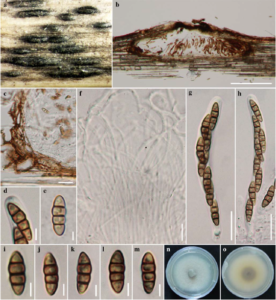Paraconiothyrium thysanolaenae Phookamsak, Chethana & K.D. Hyde.
Index Fungorum number: IF550930, Facesoffungi number: FoF00432; Fig. 1
Etymology – The specific epithet thysanolaenicola refers to the host from which the fungus was isolated.
Holotypus – MFLU 11–0142
Saprobic on stems of Thysanolaena maxima. Sexual morph Ascostromata 115 – 250 μm high, 410 – 840 μm diam., scattered or clustered, gregarious, immersed to semi-immersed, visible as raised, black structures, longitudinal axis vertical to the host surface. Locules 130 – 200 μm high, 170 – 300 μm diam., clustered, immersed under pseudoclypeus, unito multi-loculate, subglobose to quadrilateral, dark brown to black, ostioles central in each locule, with black, minute papilla. Peridium 10 – 30 μm wide, thin-walled, of equal thickness, composed of 3–5 layers, of brown to dark brown, pseudoparanchymatous cells, arranged in a textura angularis. Hamathecium of dense, 1 – 2 μm wide, filamentous, broad cellular, pseudoparaphysese, branched, anastomosing above the asci, embedded in a gelatinous matrix. Asci (52–)55–70(–75 × 6–7(–7.5) μm (x̄ = 65 × 7 μm, n = 25), 8-spored, bitunicate, fissitunicate, cylindrical, with short acute or knob-like pedicel, apically rounded with well-developed ocular chamber. Ascospores 10.5 – 12 (–13) × 3 – 4 μm (x̄ = 11.7 × 3.9 μm, n = 30), overlapping 1 – 2-seriate, phragmosporous, fusiform to ellipsoidal, brown to reddish-brown, 3-septate, constricted at the septum. Asexual morph Undetermined.
Culture characters – Colonies on MEA 78 – 84 mm diam. after 4 weeks at 25 – 30 °C, cream to orangish-white at the margins, white grey in the centre; reverse white to cream or yellowish-white at the magins, light brown to yellowish-brown at the cantre; medium dense, circular, flattened, smooth, with entire edge, fairly fluffy to flocose, slightly radiating in the lower part, not producing pigments.
Material examined – THAILAND, Chiang Mai, Mae Taeng District, Huai Nam Dung, 8 September 2009, on dead stem of Thysanolaena maxima Kuntze (Poaceae), R. Phookamsak RP0007 (MFLU 11–0142, holotype), ex-type living culture, MFLUCC 10–0550, GenBank ITS: KP744453; LSU: KP744496; SSU: KP753959.
Notes – In this study, we introduce a new sexual species in the genus Paraconiothyrium, Parac. thysanolaenae, based on the phylogenetic evidence. Paraconiothyrium thysanolaenae formed a robust clade with Parac. estuarinum and Parac. cyclothyrioides in our phylogenetic analyses. However, the species did not produce an asexual morph; thus the asexual morphology of these species is not comparable. Ariyawansa et al. (2014) reported the sexual species of Parac. fuckelii and Parac. magnolia which have clearly distinguish morphological characters as compared to Parac. thysanolaenae. Paraconiothyrium thysanolaenae differs from P. fuckelii and Parac. magnolia by its ascostromata and mucilaginous sheath surrounding the ascospores. Paraconiothyrium thysanolaenae forms pseudostromata with uni- to multilocules and ascospores lack a mucilaginous sheath, while Parac. fuckelii and Parac. magnolia have uniloculate ascomata.

Fig. 1 Paraconiothyrium thysanolaenae (holotype) a Black, raised, longitudinal ascostromata on host surface b Section of an ascoma c Peridium d Ocular chamber e Ascospore stained in Indian ink f Pseudoparaphyses g-h Asci i–m Ascospores n–o Culture characters Scale bars: b = 200 μm, c, g, h = 20μm, f = 10 μm, d, e, i, j, k, l, m = 5 μm.
